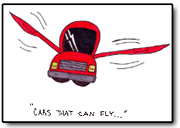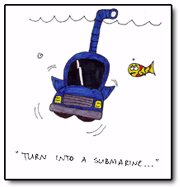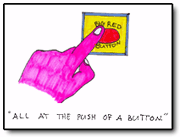|
We've probably all thought about it, while watching the Jetsons
or some other futuristic show, just what would it be like to
drive those cool futuristic cars? Cars that fly or turn into
a submarine at the push of a button? Well, we're not quite there
yet, but we are making some drastic changes to the cars we drive. |
 |
The future is much closer than we think. Car manufacturers
predict that as early as 2020, cars, as we know them , may no
longer exist. But what will the cars of the future be like?
We know for sure that we need to make cars lighter and smaller
for better mileage. Some prototypes of future cars look tall
and boxy. But Rick Schroeder of the Garden Valley Collegiate
Automotive Department disagrees with this vision.
"I do see the cars getting smaller. I don't see them
boxier," he says. "But can people afford them? That
becomes an issue of pressure."
By pressure, Schroeder means government standards and costs.
Already, government safety standards make it next to impossible
to find, buy and license a cheap old car.
Another aspect of future cars with which we are already becoming
is "smart cars". Cars today are more frequently using
the GPS (Global Positioning System. Satellites are used to find
stolen cars, unlock car doors, plot driving routes, and even
reserve tickets to events! Future smart cars may drive themselves
to a set location, finding the quickest and safest route by avoiding
traffic and accidents. And just how will these glorified hunks
of metal know about such things? Easily. They'll just "talk"
to other cars or satellites, using the radar and sensors built
into their frames. They will also use those same sensors to determine
what is around them and to adjust their speed accordingly.
 |
Then there are the famous electric cars. These are the cars most
often portrayed in movies or shows of the future--cars built
of lightweight material, environmentally friendly, and incredibly
quiet. These cars use electric motors as opposed today's polluting
gasoline cars. A drawback to electric cars is that today's prototypes
must be recharged every three to four hours, and that is obviously
not good for driving all day or long distance. But there could
be a solution to this problem. |
"Maybe you'd have a town or city car that would be electric,
where you would just do little short trips and then, for the
longer hauls, you'd have another family vehicle that runs on
diesel or gasoline," say Schroeder.
There are also other cars, not as polluting as today's cars
but not yet as environmentally friendly as the electric car.
These cars, known as hybrids, are a combination of an electric
motor and combustion engine. In some prototypes, the combustion
engine acts as a generator, taking over when speed or distance
gets to a certain point to recharge the battery. Many people
think that these hybrids are a big step towards totally electric
cars.
|
Finally, there are the vehicle entertainment systems of the
future. Already there are television and Nintendo systems in
vehicles to make trips more fun. Some, such as Christine Froese,
a Grade 11 student at G.V.C., hopes that future cars will be
able to make coffee or hot chocolate.
"Cars are becoming more comfortable. I don't think they're
necessarily the big power machines they used to be. But they're
made to get you from A to B quickly, snappily, and comfortably,"
says Schroeder. |
 |
What will the cars of the new millennium be like? These few
ideas just scratch the surface. Car manufacturers are coming
out with new ideas and designs everyday. Who knows? Maybe a hundred
years from now our cars will fly or turn into a submarine at
the push of a button. Only time will truly tell. |